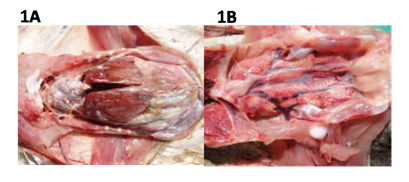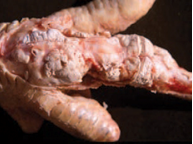Introduction
Gout is a metabolic disease associated with elevated levels of uric acid in blood and tissues where abnormal accumulation of white chalky uric acid occurs in soft tissues of various organs of body. Uric acid is a nitrogenous waste from protein breakdown. It is produced mainly in the liver and is excreted by the kidneys. In mammals, it is converted to less harmful substance with the help of the enzyme uricase. But in birds this enzyme is absent. Hence, uric acid is the final excretory product. High blood levels of uric acid favour its precipitation in tissues. Uric acid is not toxic but precipitated crystals in the form of monosodium urate crystals can cause mechanical damage to tissues like kidneys, heart, lungs, intestines and also in the joints. These crystals severely damage body tissues.
Significance
Gout is one of the economic important diseases in commercial broilers and it is responsible for a great deal of morbidity and mortality in broilers. The disease is of prime importance in poultry industry due to increased incidence causing production loss, regular mortality and lack of availability of specific treatment (Dhara et al., 2010). Bulbule et al., (2013) reported several outbreaks of gout in commercial broilers in India during 2011–2012 which caused up to 40% mortality in birds resulting in heavy economic losses to the broiler farmers.
Causes
Gout is multifactorial in origin which can be infectious, nutritional, toxic, poor management or possibly a combination of factors. The nutritional or metabolic causes of gout includes high protein diet, excess salt, excess dietary calcium, low phosphorus, imbalance in Calcium-Phosphorus levels, adulteration of feed with urea and vitamin A and D deficiency. The prolonged dehydration can trigger urolithiasis in the birds. Water deprivation followed by over dosages of certain drugs like sulphas and the antibiotic aminoglycosides (Gentamycin) often causes gout. Feed contaminated with the mycotoxins and phytotoxins impairs kidney functions leading to gout. Citrinin, ochratoxin and oosporein are the nehrotoxic and also cause gout.
Some managmental stress factors including high brooding temperature, higher level of ammonia concentration in the shed cause high mortality due to gout. Primary infectious nephritis due to bacterial agents does not appear to be common in poultry. E. coli and salmonella has occasionally been isolated from cases of pyelonephritis, but the infection is likely secondary. The infectious causes forthe development of gout are the nephropathogenic infectious bronchitis virus (IBV), avian nephritis virus (ANV), chicken astrovirus (CAstV) and infectious bursal disease (IBD) virus (Bulbule et al., 2014).
Signs and lesions
Gout is characterized by depression, dehydration and sometimes with greenish diarrhea. Affected chicks appear dull with ruffled feathers and moist vent. Mortality among young chicks is high. There is irregular and excessive enlargement of kidney lobules and cutting openthe kidney reveals urate crystals chalky white deposition of urate crystals is seen all over the visceral organs like the heart,liverand kidney under the skin etc.
Types of Gout
Depends upon the site of uric acid deposition, gout is classified as visceral gout and articular gout. A condition in which white uric acid deposits are seen in soft tissues of various organs in body especially in kidney and heart is known as visceral gout and condition in which urate crystals deposits in joints are known as articular gout.
In case of visceral gout, kidneys are swollen and contain urates (Figure. 1). Similarly urate-crystals are seen within tubules with impaction of urater, urater branches and collecting ducts resulting to damage of primary tubules or to back pressure following obstruction of urater and its branches which in turn affects normal excretory function function of kidneys. The kidney damage can arise from infection with certain strains of infectious bronchitis, avian nephritis virus, exposure to some mycotoxin or inadequate water intake. High calcium with low phosphorous diet results in precipitation of calcium sodium urate crystals. Excessive Sodium, low vitamin A diet, high protein diet (30%) and water deprivation due to any reason leads to concentration of uric acid in kidney. Hard water with higher metallic salts favors the condition and puts extra load on kidneys. Mycotoxins, ocharatoxins and oosporin, antibiotics excreting through kidneys like sulpha drugs, Gentamycin and Nitrofurans in excess dose cause renal damage. Articular gout (Figure. 2) is rarely seen and it is usually a chronic condition. Kidneys are generally normal and may become abnormal with white urate deposits if bird gets dehydrated. Main causes are genetic and high protein diet.

Figure 1A and 1B: Post mortem lesions showing urate crystal deposits in visceral organs.

Figure 2: Post mortem lesions showing urate crystal deposits in joints.
Treatment
When gout mortality is recognized, the disease cannot be corrected, but treatment may help some birds live with marginal kidney function. Current techniques for reducing gout mortality in pullets and layers rely on acidifying the urine to keep kidney stones dissolved and preserve functional renal mass of affected birds. Reduce the dose of antibiotics if given and also provide plenty of water. Check the hardness of water and it should be desirable.
Prevention and Control
Adequate water should be provided to birds. Regular checking of watering system for height, blockage and adequate flow of water is essential. During transportation of chicks from hatchery to farm ensure proper temperature and humidity to avoid dehydration. Feed with high protein content than the recommended level need to be avoided. Urine acidifiers like ammonium sulphate (5.0 g/kg BW) and ammonium chloride (10 g/kg BW) increases the acidity of the urine and helps in uric acid excretion. Meet the dietary calcium and phosphorus level carefully. It is better to provide calcium in the form of grit rather than powder as grit dissolves slowly and helps to maintain blood calcium level. Provide the feed without mycotoxin content and if found positive change the feed or use suitable toxin binders. Judiciously use the drugs which cause kidney damage. Use of electrolytes through water may assist in controlling mortality. In acute cases, potassium chloride (1 g/litre) can be used. Provide broken maize at least for 3 days and jaggery (5 g/litre) for 3-5 days in acute cases of mortality.
Conclusion
Gout in India is still one of the major causes for huge mortality and morbidity in poultry, causing great monetary losses to the producers. Breeder management along with adequate farm and hatchery management are crucial in preventing incidences of gout. Gout due to water deprivation, particularly in the winter season in India’s northern states, should be taken care of by providing optimal brooding temperatures. The producer should be proactive enough to include optimal additives/supplements in water that would aid in cutting down the usual mortality pattern. Any practice that encourages flushing out uric acid crystals should be adopted, the easiest and vital being boosting up water intake, or else the whole effort of providing medications through water can be futile.
References
- Bulbule NR, Kapgate SS and Chawak MM (2014).Infectious causes of Gout in Chickens. Advances in Animal and Veterinary Sciences 2 (4): 255 – 260.
- Bulbule NR, Mandakhalikar KD, Kapgate SS, Deshmukh VV, Schat KA, Chawak MM (2013). Role of chicken astrovirus as a causative agent of gout in commercial broilers in India.Avian Pathol. 42: 464–73. 6.
- Dhara, AK, Guha, C, Biswas U, Chakraborty GC, Sera A K and Jana PS. (2010). Therapeutic efficacy of different drugs on gout in broilers. Indian Vet. J., 87(11):1151-1153.

Dr. S. Barathiraja
Department of Veterinary Biochemistry,
Rajiv Gandhi Institute of Veterinary Education and Research,
Puducherry – 605 009

Sunil Kumar Mohapatra
Department of Veterinary Biochemistry,
Rajiv Gandhi Institute of Veterinary Education and Research, Puducherry – 605 009















